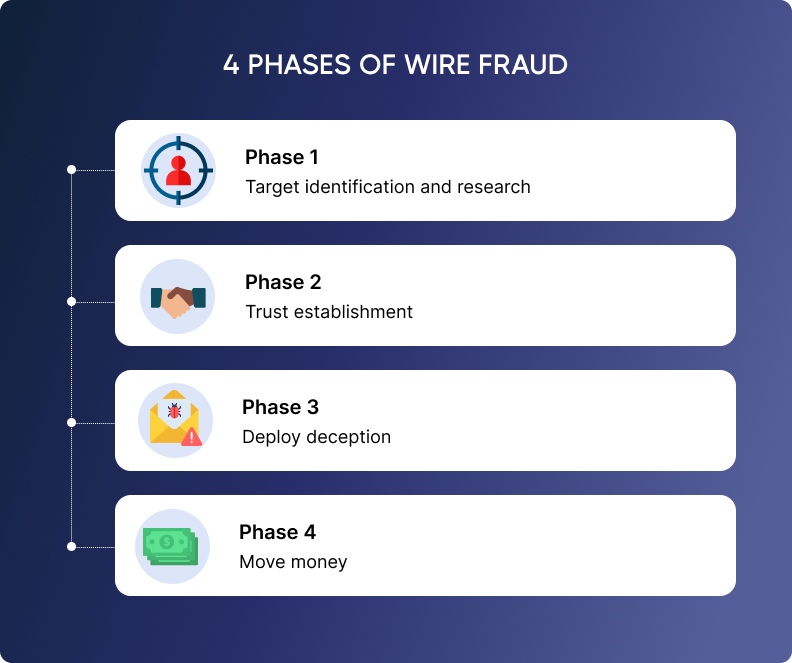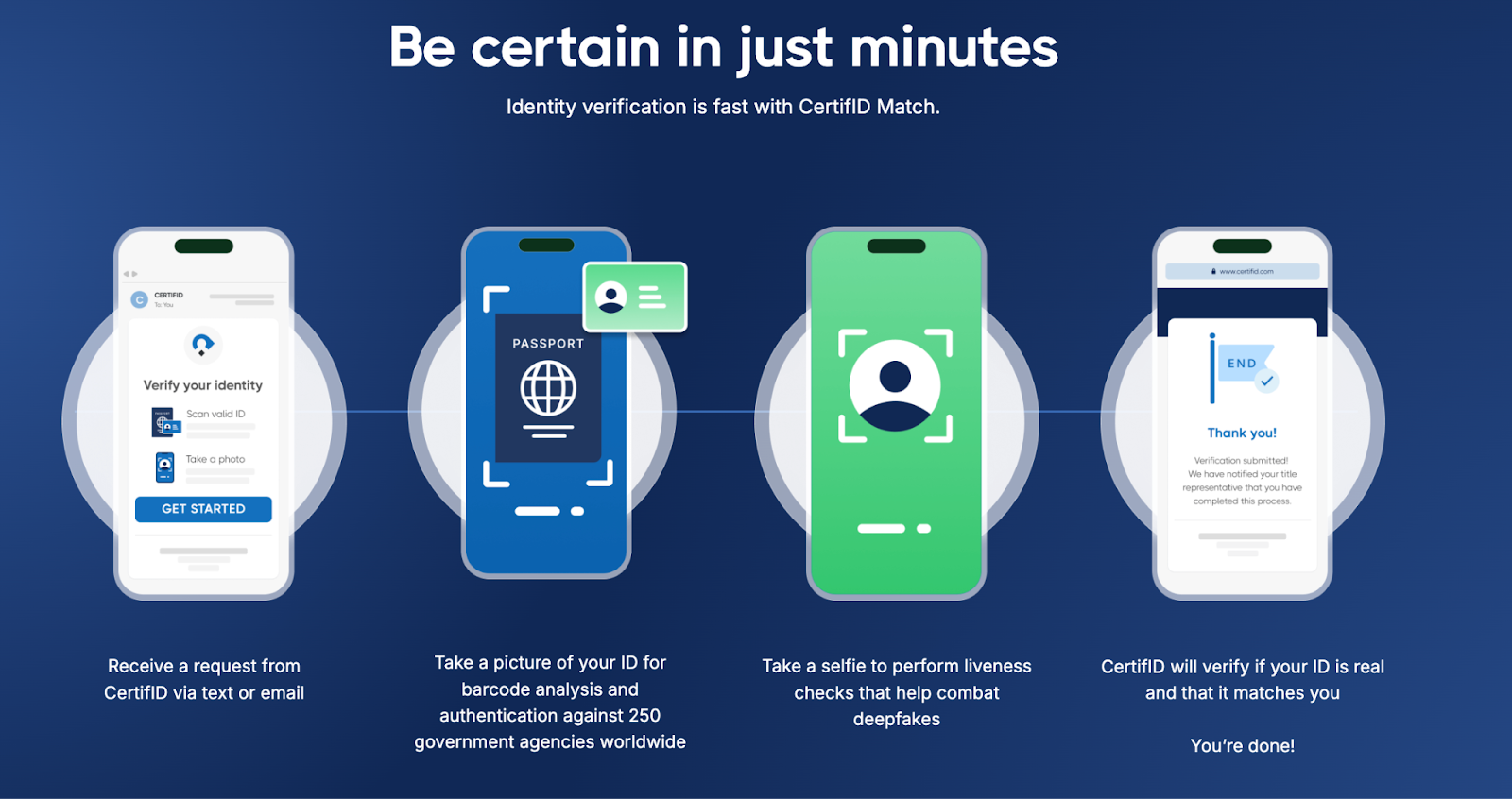What is wire fraud? Definition, examples, laws & penalties in 2025
Wire fraud schemes cost the real estate industry billions annually, but understanding the legal framework, criminal penalties, and proven prevention strategies helps you protect client funds and your reputation.

Tom Cronkright
7 minutes
Wire Fraud
Aug 13, 2025
Dec 5, 2025
“I remember the exact moment I got the call from my office saying, 'We wired a payoff yesterday, and the lender just called us and said they didn't receive the wire.'"
For Sarah, a title agent with over 20 years of experience, this was when wire fraud shifted from industry warning to business reality. Fraudsters had used public property records and basic workflow knowledge to target her company.
This case isn't isolated: FBI data shows more than $12.5 billion in cybercrime losses in 2023. The problem is growing closer to home. According to our State of Wire Fraud 2025 Report, 17% of title companies sent client money to fraudulent accounts.
For professionals handling escrow funds and settlements, wire fraud represents career-ending risk that can trigger federal prosecution and destroy reputations with a single misdirected payment.
Navigating this risk requires more than awareness. It needs a working knowledge of the statutes, penalties, and prevention strategies that apply in 2025. That’s what this guide delivers.
Wire fraud definition
Wire fraud is a federal crime under 18 U.S.C. §1343 defined as using electronic communications, such as phones, email, or the internet, to carry out a scheme intended to defraud someone for financial gain.
Examples include phishing scams, business email compromises, telemarketing scams, and fraudulent wiring instructions in real estate transactions, where victims are tricked into sending money or revealing sensitive information.
Wire fraud differs from other financial crimes:
- Bank fraud specifically targets financial institutions
- Mail fraud uses postal services instead of electronic communications
- Identity theft involves stealing personal information
- Credit card fraud focuses on payment card misuse
Penalties for wire fraud can include significant fines and imprisonment, with the FBI typically investigating such cases. Wire fraud carries up to 20 years in federal prison and $250,000 in fines. In Kousisis et al. v. United States (2024), the Supreme Court confirmed that a financial loss isn't required for conviction. Even attempted wire fraud is sufficient for federal prosecution.
Key elements of wire fraud
Understanding the four legal elements of wire fraud helps you recognize when your daily work might cross into dangerous territory. Each element applies to scenarios you encounter regularly.
- Scheme or artifice to defraud: A deliberate plan to deceive clients, colleagues, or business partners. This includes forwarding fraudulent payoff instructions that appear legitimate or failing to verify last-minute wiring changes.
- Intent to defraud (willfulness): You must knowingly participate with fraudulent intent. Accidental transmission of wrong information doesn't qualify. However, willful blindness (ignoring red flags) can qualify. Negligent practices may not prove intent, but won’t protect you if fraud occurs.
- Material misrepresentation or omission: False or misleading information that would influence the victim's financial decisions, such as fraudulent payoff amounts or bank routing numbers. This includes relaying unverified wiring changes or failing to disclose verification attempts.
- Use of interstate or international wire communications: Electronic transmission across jurisdictional boundaries. Most business emails qualify. Since electronic communications rarely stay within state lines, this element is almost always satisfied in professional settings.
The "willfulness" element protects against genuine accidents but not negligent verification practices when you have reason to suspect fraud.
How wire fraud works
Fraudsters follow a systematic four-phase process that exploits the fast-paced nature of professional services. Understanding this method helps you spot attacks before they succeed. The following example comes from real estate.
Phase 1—Target and research: Criminals study publicly available property records, transaction timing, and communication patterns. They identify high-value transactions and research the parties involved, including closing attorneys, title companies, and real estate agents.
Phase 2—Establish Trust: Fraudsters monitor email communications to understand transaction details, deadlines, and workflow patterns. They study writing styles, signature formats, and business relationships to craft convincing impersonations.
Phase 3—Deploy deception: Using familiar business language and transaction-specific details, criminals send fraudulent instructions that appear to come from legitimate sources. They create urgency around closing deadlines and use authentic-sounding explanations for wiring changes.
Phase 4—Move Money: Once fraudulent instructions are followed, criminals quickly move funds through multiple accounts to prevent recovery. This phase includes earnest money deposits, down payments, and settlement funds. Any large wire transfer becomes a target.
Fraudsters exploit urgency and familiar business language to bypass verification, taking advantage of tight deadlines and financial pressure.

Most common examples of wire fraud
Wire fraud schemes targeting business professionals fall into four major categories, each with specific tactics that exploit professional workflows and client relationships.
Business Email Compromise
Executive impersonation emails request urgent wire transfers for "confidential" transactions. Fraudsters research company hierarchies and send requests that appear to come from partners or senior attorneys. Similarly, fake vendor payment requests target accounts payable, using spoofed invoices that match legitimate vendor formats.
Account takeover schemes involve criminals gaining access to legitimate email accounts and sending fraudulent instructions that appear completely authentic. These attacks are particularly dangerous because they use real email accounts with established trust relationships.
Payoff and settlement fraud
Fake mortgage servicer instructions target closing transactions, with criminals impersonating major lenders like Wells Fargo or Chase. They provide fraudulent payoff amounts and wiring instructions that appear to come from legitimate servicer email domains.
Settlement fund diversions involve last-minute changes to established wiring instructions, often explained away as "system updates" or "new procedures." These schemes target the final stages of transactions when time pressure is highest.
Client impersonation schemes
Buyer impersonation attacks involve criminals studying property records and transaction details to pose as home buyers. They contact title companies directly with urgent requests to change wiring instructions for down payments or closing funds.
Seller fraud schemes target net proceeds from property sales, with fraudsters claiming banking changes require new wiring information. These attacks often occur just before closing, when sellers are most vulnerable to last-minute complications.
Vendor fraud
Service provider impersonation involves criminals posing as inspection companies, appraisers, or other transaction vendors. They send fraudulent invoices with updated payment instructions that appear legitimate but direct funds to criminal accounts.
Attorney impersonation schemes target opposing counsel relationships, with fraudsters sending settlement fund instructions that appear to come from legitimate law firms. These attacks exploit professional courtesy and established business relationships.
Scale of the threat
The FBI reports that business email compromise schemes generated $2.77 billion in losses in 2024, with recovery rates remaining low. Recovery of misdirected funds remains limited, underscoring the scale and persistence of the threat.
Federal laws and penalties for wire fraud
Wire fraud carries severe penalties under 18 U.S.C. §1343, including up to 20 years in federal prison and substantial fines up to $250,000 for individuals. This type of crime is actively pursued by federal prosecutors in professional service settings.
Enhanced penalties apply when schemes affect financial institutions, raising maximum sentences to 30 years and fines up to $1 million. Since most real estate transactions involve banks, credit unions, or mortgage companies, these enhanced penalties frequently apply to professionals in our industry.
Professional consequences extend beyond criminal penalties. License revocations affect attorneys and real estate professionals, while civil liability exposes firms to client lawsuits and malpractice claims. To make matters worse, professional liability insurance policies often exclude wire fraud losses, leaving firms financially exposed.
How wire fraud is investigated: Three institutions you must know
Three federal agencies handle wire fraud investigations, each with distinct roles in the process. Understanding their functions helps you navigate potential fraud incidents and recovery efforts.
- The FBI's Internet Crime Complaint Center collects initial reports and coordinates with field offices for investigation.
- The Department of Justice prosecutes complex cases and coordinates with state authorities.
- The Secret Service focuses on financial crimes and maintains specialized fraud investigation units.
These agencies collaborate with industry partners like CertifID who maintain direct law enforcement relationships for recovery efforts.
The investigative work itself is carried out by federal teams. Digital forensics analyze email headers and IP addresses, financial investigators trace wire paths through banking networks, and agents examine communication patterns to identify fraud schemes.
Professional reputations suffer during investigation periods, making prevention through verification software more valuable than the slow and uncertain prospect of recovery.
And even with law enforcement cooperation, recovery is still difficult. This shows the sharp limits of investigation once funds are gone.
How to protect yourself against wire fraud
Protection requires both systematic verification protocols and immediate response procedures. Your reputation and career depend on implementing these fraud prevention measures rather than hoping for successful recovery.
Rely on professional anti-fraud software
Start with verification software that confirms the identity of parties involved and ensures you have correct wiring information. Wire fraud protection platforms provide real-time verification that stops fraud before funds move, offering better protection than manual verification attempts.

Establish strict verification requirements for all transactions, regardless of the dollar amount. Instead of using verbal confirmation through phone numbers or email, verify wiring instructions via secure software that analyzes multiple markers before providing you with verification details.
Require all parties involved in the transactions to get verified and maintain audit trails for compliance purposes.
Spot these red flags before it’s too late
Wire fraud attempts often follow a predictable pattern. Recognizing these warning signs early is one of the best defenses against wire fraud:
- Urgent requests with tight deadlines that pressure you to bypass normal checks.
- Last-minute changes to established wiring instructions, often citing “system updates” or “new procedures.”
- Email addresses with subtle variations from known contacts, signaling impersonation attempts.
- Generic or vague language that avoids transaction-specific details.
- Wiring requests to unfamiliar accounts that don’t match established patterns.
Train your team to recognize these signs and verify independently before releasing funds.
Have an emergency response protocol in place
When you suspect fraud, immediately contact your bank to place holds on pending wire transfers. Document all communications and verification attempts for law enforcement and compliance purposes. Report suspected fraud to the FBI Internet Crime Complaint Center within 24-48 hours.
Implement your firm's emergency protocols and notify insurance carriers of potential exposure without delay, as some policies require prompt notice to preserve coverage. Equally important, contact wire fraud recovery services immediately, as quick action provides the best chance of fund recovery.

Protect your customers
First-time home buyers and sellers look to their real estate agents for security guidance more than experienced clients do. According to our State of Wire Fraud report, 35% of first-time buyers and sellers expect their agent to protect them against wire fraud, compared to just 20% of experienced clients.
When you educate clients about wire fraud risks and implement strong verification protocols, you position yourself as the trusted advisor they need during high-stakes transactions. Teaching buyers and sellers to verify wiring instructions through secure channels rather than email closes the gaps that criminals target.
Your proactive approach to security becomes a competitive advantage that builds long-term client relationships based on trust and protection.
Wire fraud: What you should do next
Protecting your reputation and staying compliant requires systematic fraud prevention protocols. Manual verification processes aren't sufficient against criminal operations that study your communication patterns and exploit professional courtesy.
That’s why secure wire verification software like CertifID is critical. It defends against evolving criminal tactics while maintaining compliance with professional standards. Protect your clients and your reputation. See CertifID in action today.

FAQ
Can wire fraud be reversed or recovered?
Unlike credit card transactions, wire transfers are typically irreversible. Quick action may allow banks to freeze funds before withdrawal, but recovery rates remain low.
Is attempted wire fraud still a federal crime?
Yes. Under 18 U.S.C. §1343, you can face federal charges for wire fraud even if no money is actually stolen. The criminal intent and use of electronic communications are sufficient for prosecution.
What's the difference between wire fraud and bank fraud?
Wire fraud involves any electronic communication used to defraud, while bank fraud specifically targets financial institutions. Many professional service schemes involve both charges.
How long do federal wire fraud investigations take?
Business-related wire fraud investigations typically require 12-18 months for completion, sometimes longer for international schemes involving multiple jurisdictions.
Are businesses liable for wire fraud losses?
Professional liability varies by circumstance, but firms may face civil liability for failing to implement reasonable verification procedures. Many professional liability insurance policies exclude wire fraud losses.
What should I do if I receive suspicious wiring instructions?
Never act on suspicious instructions. Verify through secure wire fraud prevention software, never through emails. Document all verification attempts and implement your firm's emergency protocols if fraud is suspected.
Co-founder & Executive Chairman
Tom Cronkright is the Executive Chairman of CertifID, a technology platform designed to safeguard electronic payments from fraud. He co-founded the company in response to a wire fraud he experienced and the rising instances of real estate wire fraud. He also serves as the CEO of Sun Title, a leading title agency in Michigan. Tom is a licensed attorney, real estate broker, title insurance producer and nationally recognized expert on cybersecurity and wire fraud.
“I remember the exact moment I got the call from my office saying, 'We wired a payoff yesterday, and the lender just called us and said they didn't receive the wire.'"
For Sarah, a title agent with over 20 years of experience, this was when wire fraud shifted from industry warning to business reality. Fraudsters had used public property records and basic workflow knowledge to target her company.
This case isn't isolated: FBI data shows more than $12.5 billion in cybercrime losses in 2023. The problem is growing closer to home. According to our State of Wire Fraud 2025 Report, 17% of title companies sent client money to fraudulent accounts.
For professionals handling escrow funds and settlements, wire fraud represents career-ending risk that can trigger federal prosecution and destroy reputations with a single misdirected payment.
Navigating this risk requires more than awareness. It needs a working knowledge of the statutes, penalties, and prevention strategies that apply in 2025. That’s what this guide delivers.
Wire fraud definition
Wire fraud is a federal crime under 18 U.S.C. §1343 defined as using electronic communications, such as phones, email, or the internet, to carry out a scheme intended to defraud someone for financial gain.
Examples include phishing scams, business email compromises, telemarketing scams, and fraudulent wiring instructions in real estate transactions, where victims are tricked into sending money or revealing sensitive information.
Wire fraud differs from other financial crimes:
- Bank fraud specifically targets financial institutions
- Mail fraud uses postal services instead of electronic communications
- Identity theft involves stealing personal information
- Credit card fraud focuses on payment card misuse
Penalties for wire fraud can include significant fines and imprisonment, with the FBI typically investigating such cases. Wire fraud carries up to 20 years in federal prison and $250,000 in fines. In Kousisis et al. v. United States (2024), the Supreme Court confirmed that a financial loss isn't required for conviction. Even attempted wire fraud is sufficient for federal prosecution.
Key elements of wire fraud
Understanding the four legal elements of wire fraud helps you recognize when your daily work might cross into dangerous territory. Each element applies to scenarios you encounter regularly.
- Scheme or artifice to defraud: A deliberate plan to deceive clients, colleagues, or business partners. This includes forwarding fraudulent payoff instructions that appear legitimate or failing to verify last-minute wiring changes.
- Intent to defraud (willfulness): You must knowingly participate with fraudulent intent. Accidental transmission of wrong information doesn't qualify. However, willful blindness (ignoring red flags) can qualify. Negligent practices may not prove intent, but won’t protect you if fraud occurs.
- Material misrepresentation or omission: False or misleading information that would influence the victim's financial decisions, such as fraudulent payoff amounts or bank routing numbers. This includes relaying unverified wiring changes or failing to disclose verification attempts.
- Use of interstate or international wire communications: Electronic transmission across jurisdictional boundaries. Most business emails qualify. Since electronic communications rarely stay within state lines, this element is almost always satisfied in professional settings.
The "willfulness" element protects against genuine accidents but not negligent verification practices when you have reason to suspect fraud.
How wire fraud works
Fraudsters follow a systematic four-phase process that exploits the fast-paced nature of professional services. Understanding this method helps you spot attacks before they succeed. The following example comes from real estate.
Phase 1—Target and research: Criminals study publicly available property records, transaction timing, and communication patterns. They identify high-value transactions and research the parties involved, including closing attorneys, title companies, and real estate agents.
Phase 2—Establish Trust: Fraudsters monitor email communications to understand transaction details, deadlines, and workflow patterns. They study writing styles, signature formats, and business relationships to craft convincing impersonations.
Phase 3—Deploy deception: Using familiar business language and transaction-specific details, criminals send fraudulent instructions that appear to come from legitimate sources. They create urgency around closing deadlines and use authentic-sounding explanations for wiring changes.
Phase 4—Move Money: Once fraudulent instructions are followed, criminals quickly move funds through multiple accounts to prevent recovery. This phase includes earnest money deposits, down payments, and settlement funds. Any large wire transfer becomes a target.
Fraudsters exploit urgency and familiar business language to bypass verification, taking advantage of tight deadlines and financial pressure.

Most common examples of wire fraud
Wire fraud schemes targeting business professionals fall into four major categories, each with specific tactics that exploit professional workflows and client relationships.
Business Email Compromise
Executive impersonation emails request urgent wire transfers for "confidential" transactions. Fraudsters research company hierarchies and send requests that appear to come from partners or senior attorneys. Similarly, fake vendor payment requests target accounts payable, using spoofed invoices that match legitimate vendor formats.
Account takeover schemes involve criminals gaining access to legitimate email accounts and sending fraudulent instructions that appear completely authentic. These attacks are particularly dangerous because they use real email accounts with established trust relationships.
Payoff and settlement fraud
Fake mortgage servicer instructions target closing transactions, with criminals impersonating major lenders like Wells Fargo or Chase. They provide fraudulent payoff amounts and wiring instructions that appear to come from legitimate servicer email domains.
Settlement fund diversions involve last-minute changes to established wiring instructions, often explained away as "system updates" or "new procedures." These schemes target the final stages of transactions when time pressure is highest.
Client impersonation schemes
Buyer impersonation attacks involve criminals studying property records and transaction details to pose as home buyers. They contact title companies directly with urgent requests to change wiring instructions for down payments or closing funds.
Seller fraud schemes target net proceeds from property sales, with fraudsters claiming banking changes require new wiring information. These attacks often occur just before closing, when sellers are most vulnerable to last-minute complications.
Vendor fraud
Service provider impersonation involves criminals posing as inspection companies, appraisers, or other transaction vendors. They send fraudulent invoices with updated payment instructions that appear legitimate but direct funds to criminal accounts.
Attorney impersonation schemes target opposing counsel relationships, with fraudsters sending settlement fund instructions that appear to come from legitimate law firms. These attacks exploit professional courtesy and established business relationships.
Scale of the threat
The FBI reports that business email compromise schemes generated $2.77 billion in losses in 2024, with recovery rates remaining low. Recovery of misdirected funds remains limited, underscoring the scale and persistence of the threat.
Federal laws and penalties for wire fraud
Wire fraud carries severe penalties under 18 U.S.C. §1343, including up to 20 years in federal prison and substantial fines up to $250,000 for individuals. This type of crime is actively pursued by federal prosecutors in professional service settings.
Enhanced penalties apply when schemes affect financial institutions, raising maximum sentences to 30 years and fines up to $1 million. Since most real estate transactions involve banks, credit unions, or mortgage companies, these enhanced penalties frequently apply to professionals in our industry.
Professional consequences extend beyond criminal penalties. License revocations affect attorneys and real estate professionals, while civil liability exposes firms to client lawsuits and malpractice claims. To make matters worse, professional liability insurance policies often exclude wire fraud losses, leaving firms financially exposed.
How wire fraud is investigated: Three institutions you must know
Three federal agencies handle wire fraud investigations, each with distinct roles in the process. Understanding their functions helps you navigate potential fraud incidents and recovery efforts.
- The FBI's Internet Crime Complaint Center collects initial reports and coordinates with field offices for investigation.
- The Department of Justice prosecutes complex cases and coordinates with state authorities.
- The Secret Service focuses on financial crimes and maintains specialized fraud investigation units.
These agencies collaborate with industry partners like CertifID who maintain direct law enforcement relationships for recovery efforts.
The investigative work itself is carried out by federal teams. Digital forensics analyze email headers and IP addresses, financial investigators trace wire paths through banking networks, and agents examine communication patterns to identify fraud schemes.
Professional reputations suffer during investigation periods, making prevention through verification software more valuable than the slow and uncertain prospect of recovery.
And even with law enforcement cooperation, recovery is still difficult. This shows the sharp limits of investigation once funds are gone.
How to protect yourself against wire fraud
Protection requires both systematic verification protocols and immediate response procedures. Your reputation and career depend on implementing these fraud prevention measures rather than hoping for successful recovery.
Rely on professional anti-fraud software
Start with verification software that confirms the identity of parties involved and ensures you have correct wiring information. Wire fraud protection platforms provide real-time verification that stops fraud before funds move, offering better protection than manual verification attempts.

Establish strict verification requirements for all transactions, regardless of the dollar amount. Instead of using verbal confirmation through phone numbers or email, verify wiring instructions via secure software that analyzes multiple markers before providing you with verification details.
Require all parties involved in the transactions to get verified and maintain audit trails for compliance purposes.
Spot these red flags before it’s too late
Wire fraud attempts often follow a predictable pattern. Recognizing these warning signs early is one of the best defenses against wire fraud:
- Urgent requests with tight deadlines that pressure you to bypass normal checks.
- Last-minute changes to established wiring instructions, often citing “system updates” or “new procedures.”
- Email addresses with subtle variations from known contacts, signaling impersonation attempts.
- Generic or vague language that avoids transaction-specific details.
- Wiring requests to unfamiliar accounts that don’t match established patterns.
Train your team to recognize these signs and verify independently before releasing funds.
Have an emergency response protocol in place
When you suspect fraud, immediately contact your bank to place holds on pending wire transfers. Document all communications and verification attempts for law enforcement and compliance purposes. Report suspected fraud to the FBI Internet Crime Complaint Center within 24-48 hours.
Implement your firm's emergency protocols and notify insurance carriers of potential exposure without delay, as some policies require prompt notice to preserve coverage. Equally important, contact wire fraud recovery services immediately, as quick action provides the best chance of fund recovery.

Protect your customers
First-time home buyers and sellers look to their real estate agents for security guidance more than experienced clients do. According to our State of Wire Fraud report, 35% of first-time buyers and sellers expect their agent to protect them against wire fraud, compared to just 20% of experienced clients.
When you educate clients about wire fraud risks and implement strong verification protocols, you position yourself as the trusted advisor they need during high-stakes transactions. Teaching buyers and sellers to verify wiring instructions through secure channels rather than email closes the gaps that criminals target.
Your proactive approach to security becomes a competitive advantage that builds long-term client relationships based on trust and protection.
Wire fraud: What you should do next
Protecting your reputation and staying compliant requires systematic fraud prevention protocols. Manual verification processes aren't sufficient against criminal operations that study your communication patterns and exploit professional courtesy.
That’s why secure wire verification software like CertifID is critical. It defends against evolving criminal tactics while maintaining compliance with professional standards. Protect your clients and your reputation. See CertifID in action today.

Co-founder & Executive Chairman
Tom Cronkright is the Executive Chairman of CertifID, a technology platform designed to safeguard electronic payments from fraud. He co-founded the company in response to a wire fraud he experienced and the rising instances of real estate wire fraud. He also serves as the CEO of Sun Title, a leading title agency in Michigan. Tom is a licensed attorney, real estate broker, title insurance producer and nationally recognized expert on cybersecurity and wire fraud.
Sign up for The Wire to join the conversation.




.png)




